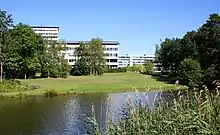Ghetto (Denmark)
A particularly vulnerable public housing area (Danish: Særligt udsat alment boligområde) is a district in Denmark with social problems, and which usually has a majority population of non-Western ethnicities.[1][2] Such areas are often referred to in Danish as "ghettos",[3] and an annual "ghetto list" (ghettolisten) has been published by the Danish Ministry of Transport, Building and Housing since 2010.[4][5]

Until May 2018
At least three of the following five criteria had to be fulfilled for a district to be included on the list:[6]
- The share of inhabitants aged 18–64 neither in employment nor education is higher than 40%, as an average over the span of 2 years.
- The share of immigrants and their descendants from non-Western countries is higher than 50%.
- The share of inhabitants aged 18 and over convicted for infractions against the penal law, weapons law or drug regulations is greater than 2.7%, as an average over the span of 2 years.
- The share of inhabitants of aged 30–59 with only primary education or less, is greater than 50%.
- The average gross income for inhabitants aged 18–64 excluding those in education is less than 55% of the average gross income for the region in question.
In 2017, no area fulfilled all five criteria, but four districts fulfilled four criteria: Mjølnerparken in Copenhagen, Gadehavegård in Høje-Taastrup, Vollsmose in Odense and Gellerupparken/Toveshøj in Aarhus.[6] Prior to the May 2018 revision of the criteria, 22 districts were on the list.[7]
May 2018 criteria
In May 2018 the criteria were revised and districts with three out of the five criteria were placed on the list. That changed the number of ghetto districts from 22 to 30.[7]
- Many inhabitants lack employment or education. Only educations approved in Denmark count.[7]
- There are many inhabitants who have only primary education (Folkeskole)[7]
- Many inhabitants have low income.[7]
- There are three times as many people with criminal convictions compared to the average for the country.
- More than half the inhabitants are from non-Western countries or are descendants of migrants non-Western countries.[7]
Severe ghettos
A district that remains four years in a row on the list is then classified to be a severe ghetto (Danish: hård ghetto). In May 2018 there were 16 severe ghettoes.[9] Individuals receiving social welfare such as social benefits, education aid or integration aid are not allowed to settle in severe ghettoes.[9]
Government response
In March 2018, the government of Denmark presented an action plan with 22 proposals where the Denmark would be rid of the ghettoes by 2030. Among the suggestions were funds of 12 billion DKK to have some districts demolished and others redeveloped.[10] Regulations would change to facilitate evictions of criminals from their housing in the ghettoes.[10] The plan was accepted by the Danish parliament in May 2018.[11] On the same occasion, the criteria for list inclusion were changed.[7]
Before children in ghettoes start school, they will undergo a Danish language test and be offered language training before the school starts.[9]
Public housing
The share of public housing in ghetto areas would be reduced to a maximum of 40% in districts that had been on the ghetto list for 4 consecutive years. Consequently, 9 buildings with 600 apartments in the Gellerup district and 3 buildings with 318 in the Bispehaven district of Aarhus are to be demolished, displacing 1,000 families.[12] In their stead, 2000 homes for ownership and 657 business properties are planned to be built.[13]
All meetings of housing associations are to be held in Danish, even if some housing association board members do not speak the language.[11]
Moving restrictions
Convicted criminals and people on public welfare would face restrictions on moving to areas on the list.[11]
Name change
In June 2019 a new social democratic government was formed in Denmark, with Kaare Dybvad becoming housing minister. Dybvad said that official use of the word "ghetto" in reference to marginalized areas is "derogatory", and he wanted to put an end to political use of the word in order to avoid stigmatizing the areas.[14][15]
See also
- Immigration to Denmark
- Vulnerable areas in Sweden
- Sensitive urban zones in France
References
- "UDSATTE BOLIGOMRÅDER – DE NÆSTE SKRIDT" (PDF). ft.dk. The Immigration and Integration Affairs Committee of the Danish Parliament. May 2013.
- "Almene boliger – beboersammensætning, sundhed og beskæftigelse" (PDF). kl.dk. "Local Government Denmark". (Retrieved 3 July 2019)
- "Hvad betyder ghetto egentlig?". DR (in Danish). Retrieved 2018-02-19.
- "Her er den nye ghettoliste: Rekordfå ghettoområder i Danmark". www.b.dk (in Danish). 2017-12-01. Retrieved 2018-02-19.
- "I Danmarks fjerde største by har man ingen ghetto: Bydel i Aalborg har fået stort løft". DR (in Danish). Retrieved 2019-05-26.
- "Ghettolisten 2017 - Transportministeriet". www.trm.dk (in Danish). Retrieved 2018-02-19.
- "Disse boligområder er nu på ghettolisten". DR (in Danish). Retrieved 2018-07-14.
- Ahlmann-Jensen, Camilla (22 May 2019). "To partier er sprunget fra Vollsmose-planen: - Den bygger på tvangsflytning af uskyldige mennesker". Fyens Stiftstidende. Odense.
- "Flertal forbyder kontanthjælpsmodtagere at flytte i ghettoer". DR (in Danish). Retrieved 2018-07-14.
- "Ny plan mod ghettoer". DR (in Danish). Retrieved 2018-07-14.
- "Bredt flertal laver ghettoaftale". DR (in Danish). Retrieved 2018-07-14.
- "1000 familier i Aarhus skal flytte på grund af ghettoplan". DR (in Danish). Retrieved 2018-07-14.
- "1000 familier i Aarhus skal flytte på grund af ghettoplan". DR (in Danish). Retrieved 2018-07-14.
- Thelocal.dk. Denmark's housing minister wants to scrap 'ghetto' label for underprivileged areas. Retrieved 5 April 2020
- DR. Ny boligminister vil undgå ordet 'ghetto'. (in Danish) Retrieved 6 April 2020
